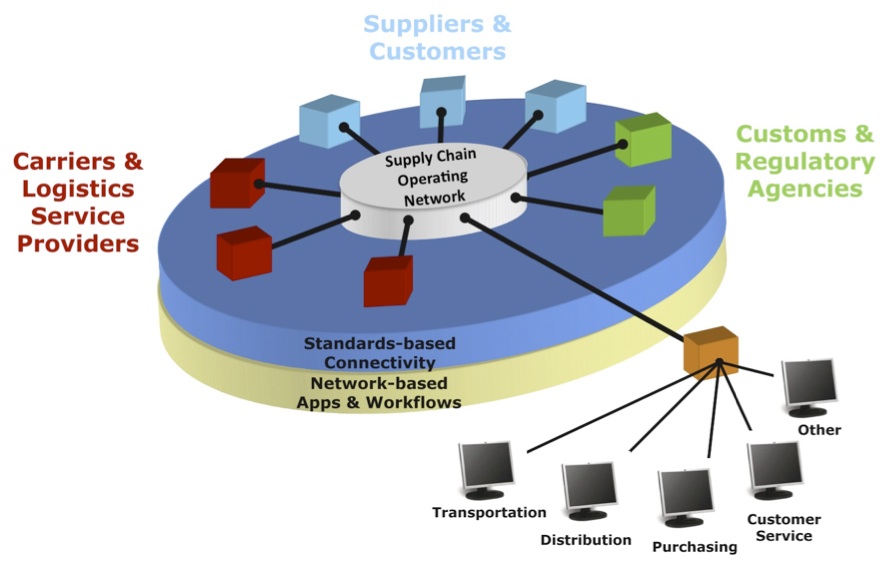Is it time for supply chain executives to step into a new leadership role, that of Chief Network Effects Officer (CNEO)?
For more than a decade, I’ve been talking about the rise of Supply Chain Operating Networks — the business equivalent of LinkedIn and Facebook — that serve as the platform for enabling the network effect in supply chain and logistics.

Supply Chain Operating Networks bring together trading partner connectivity with software-as-a-service applications. Instead of companies creating hundreds or thousands of one-to-one connections with their trading partners, they make a single connection to the business network, where their trading partners and thousands of other companies are also connected, and they use the SaaS applications that reside on the network to communicate, collaborate, and execute business processes in more efficient, scalable, and innovative ways.
Earlier this week, I came across a research paper by Michael Schrage, “Rethinking Networks: Exploring Strategies for Making Users More Valuable,” published by MIT Sloan School’s Initiative on the Digital Economy. It’s a brief but thought-provoking paper that you have to read more than once to fully grasp the core principles and practices Schrage presents for facilitating network effects. Here’s an excerpt from the paper where he defines network effects, adding an important element to the traditional definition:
Technically, economists say ‘network effects’ — known also as ‘network externalities’ — exist when a product’s or service’s value to users increases as the number of users grow. But this traditional definition is woefully incomplete. Quality of use and users matters as much or more to value creation as quantity [emphasis mine]. In other words, the ‘how’ is as important as the ‘how much.’
Schrage also presents three key questions to assess the return on investment (ROI) of network effects:
- How do we make it easier for our users to participate and create ‘connections’ they see as valuable?
- How do we make it easier for ourselves to identify value from user participation, contributions, and links?
- How should we (re)organize ourselves to best harvest the value of ‘network effects’ to measurably boost the quality, opportunity, and ‘user experiences’ of our offerings?
The “we” in the questions above refer primarily to network/platform providers, but I believe supply chain executives need to ask the same questions too. In other words, I believe the time has come for companies to view supply chain management through a ‘network effects’ prism, and when you do that, we’ll see today’s supply chain leaders and teams morph into tomorrow’s Chief Network Effects Officers and Network Effects teams.
“Who should be accountable for identifying, cultivating and coordinating network effects inside the enterprise and out?” asks Schrage in a December 2013 HBR post (Who’s Managing Your Company’s Network Effects?), where he introduces the concept of a Chief Network Effects Officer. “Your organization needs a CNEO—a Chief Network Effects Officer—to integrate and align how your enterprise gets value from ‘harvesting collective intelligence.’”
So, yes, I believe the time has come for supply chain executives to step into the role of Chief Network Effects Officer.
Where do you begin?
First, educate yourself about “network effects” and how they currently exist in supply chain management, and what opportunities lie ahead. Below are links to some posts we have published related to this topic, as well as two Talking Logistics episodes (The Power of a Supply Chain Operating Network and A New Age in Supply Chains: Realizing the Benefits of Business Networks and Communities) that provide additional insight. In his recent paper, Schrage also outlines a research framework — “The Triple S” — that deconstructs network effects into three interrelated components: Segmentation, Socialization, and Skill-ification. According to Schrage, “organizations around the world have successfully employed this framework to usefully experiment with network effects.”
Second, get the conversation started with your teams about network effects, as well as your suppliers, customers, logistics service providers, and other external partners. The three questions highlighted above, along with the concepts presented in the Triple S framework, are a good catalyst for conversation.
Third, do something — don’t just think and talk about network effects. Determining what steps to take should be one of the outcomes from your team and trading partner conversations.
Why does this matter? Because, as I’ve said many times before, the greatest opportunities for supply chain innovation exist at the intersection of Software, B2B Connectivity, and Social Networking. And as Schrage writes:
The more users participate [in a network], the more value — and valuable experiences — can quickly be generated. And the more value created, the more users — and innovative uses — materialize.
That virtuous value cycle simultaneously disrupts and transforms industries worldwide [emphasis mine]. Value can exponentially increase as costs only marginally grow. This makes the economics of ‘network effects’ combinatorially compelling.
But tapping into these opportunities requires companies to take a fresh look at their supply chain strategies, processes, technology, and people from a network effects perspective — and then having the courage to pick up a new compass and journey toward a different, more promising and exciting, future.
For related commentary, please read and watch the following Talking Logistics posts and video episodes:
- The Network Effect in Supply Chain and Logistics
- The Rise of Supply Chain Operating Networks
- A Pulse on Social Networking for Supply Chain Management
- Where to Find Supply Chain Innovation
- Enabling Labor, Freight, and Cash-to-Cash Savings with Supply Chain Operating Networks
- HP’s New Style of IT: The Social Supply Chain
- Facebook Graph Search, Through a Supply Chain Lens
The Power of a Supply Chain Operating Network
A New Age in Supply Chains: Realizing the Benefits of Business Networks and Communities










